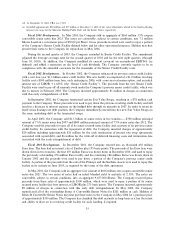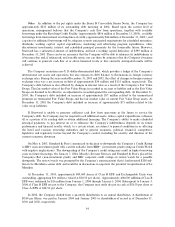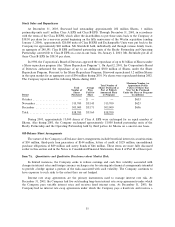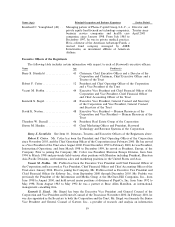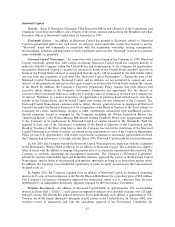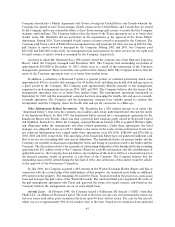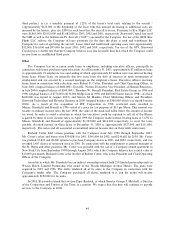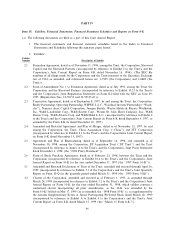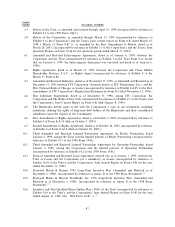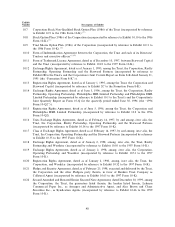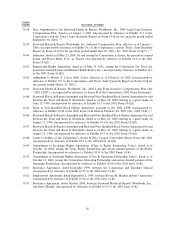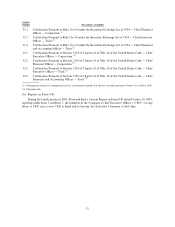Starwood 2003 Annual Report Download - page 52
Download and view the complete annual report
Please find page 52 of the 2003 Starwood annual report below. You can navigate through the pages in the report by either clicking on the pages listed below, or by using the keyword search tool below to find specific information within the annual report.Starwood Capital
General. Barry S. Sternlicht, Chairman, Chief Executive OÇcer and a Director of the Corporation, and
Chairman, Chief Executive OÇcer and a Trustee of the Trust, controls and has been the President and Chief
Executive OÇcer of Starwood Capital since its formation in 1991.
Trademark License. An aÇliate of Starwood Capital has granted to Starwood, subject to Starwood
Capital's unrestricted right to use such name, an exclusive, non-transferable, royalty-free license to use the
""Starwood'' name and trademarks in connection with the acquisition, ownership, leasing, management,
merchandising, operation and disposition of hotels worldwide, and to use the ""Starwood'' name in its corporate
name worldwide, in perpetuity.
Starwood Capital Noncompete. In connection with a restructuring of the Company in 1995, Starwood
Capital voluntarily agreed that, with certain exceptions, Starwood Capital would not compete directly or
indirectly with the Company within the United States and would present to the Company all opportunities
presented to Starwood Capital to acquire fee interests in hotels in the United States and debt interests in
hotels in the United States where it is anticipated that the equity will be acquired by the debt holder within
one year from the acquisition of such debt (the ""Starwood Capital Noncompete''). During the term of the
Starwood Capital Noncompete, Starwood Capital and its aÇliates are not permitted to acquire any such
interest, or any ground lease interest or other equity interest, in hotels in the United States without the consent
of the Board. In addition, the Company's Corporate Opportunity Policy requires that each director and
executive oÇcer submit to the Corporate Governance Committee any opportunity that the director or
executive oÇcer reasonably believes is within the Company's lines of business or in which the Company has
an interest. Therefore, as a matter of practice, all opportunities to purchase hotel-related assets, even those
outside of the United States, that Starwood Capital may pursue are Ñrst presented to the Company. The
Starwood Capital Noncompete continues until no oÇcer, director, general partner or employee of Starwood
Capital is on either the Board of Directors of the Corporation or the Board of Trustees of the Trust (subject to
exceptions for certain restructurings, mergers or other combination transactions with unaÇliated parties).
Several properties owned or managed by the Company, including the Westin Innisbrook Resort (the
""Innisbrook Resort''), the Westin Mission Hills Resort and the Turnberry Hotel, were opportunities brought
to the Company or its predecessors by Starwood Capital or entities related to Mr. Sternlicht. With the
approval in each case of the Governance Committee of the Board of Directors of the Corporation and the
Board of Trustees of the Trust, from time to time the Company has waived the restrictions of the Starwood
Capital Noncompete, in whole or in part, (or passed on the opportunity in cases of the Corporate Opportunity
Policy for non-U.S. opportunities) with respect to particular acquisition or investment opportunities in which
the Company had no business or strategic interest. Since 1995, Starwood Capital made four such investments.
In July 2003, the Company waived the Starwood Capital Noncompete in connection with the acquisition
of the Rennaisance Wailea Hotel in Hawaii by an aÇliate of Starwood Capital. The Company has signed a
letter of intent with the aÇliate to manage this property after it is extensively repositioned and renovated. The
Company is currently negotiating the management agreement. The Company's Governance Committee,
advised by separate independent legal and hospitality advisors, approved the waiver of the Starwood Capital
Noncompete and the terms of the proposed management agreement as being at or better than market terms.
In addition, the Company was provided the opportunity to make an equity investment in the transaction but
declined to do so.
In August 2003, the Company acquired from an aÇliate of Starwood Capital, its beneÑcial ownership
interest in 15 acres of land contiguous to the Westin Mission Hills Resort for a purchase price of $2.8 million.
The Company's Governance Committee approved the transaction, which was at a discount from the price
determined by an independent third party appraiser engaged by the Governance Committee.
Portfolio Investments. An aÇliate of Starwood Capital holds an approximately 31% co-controlling
interest in Troon Golf (""Troon''), a golf course management company that currently manages over 120 high-
end golf courses. Mr. Sternlicht's indirect interest in Troon held through such aÇliate is approximately 12%.
Troon is one of the largest third-party managers of golf courses in the United States. In January 2002, after
extensive review of alternatives and with the unanimous approval of the Governance Committee, the
42



